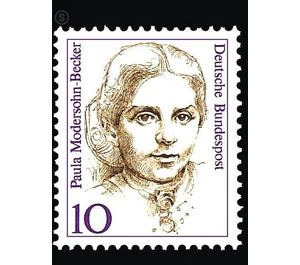Postage stamp: Women of German History - Germany / Federal Republic of Germany 1988 - 10 Pfennig
Theme: Health & Human
| Country | Germany / Federal Republic of Germany |
| Issue Date | 1988 |
| Face Value | 10.00 |
| Color | brown white |
| Perforation | K 14 |
| Printing Type | 2-color Typography |
| Stamp Type | Postage stamp |
| Item Type | Stamp |
| Chronological Issue Number | 1232 |
| Chronological Chapter | GER-BRD |
| Michel ID | BRD 1359 |
| SID | 685029 |
| In 96 Wishlists | |
With »Women of German History« the Deutsche Bundespost replaces the series »Industry and Technology« begun in 1975/76. The new series is intended to help raise awareness of women's achievements in society. The new 10 Pf value appears at the same time and same motif in the issues »German Federal Post« and »German Federal Post Berlin«. Not much spoke in favor of Paula Becker becoming an important artist. Paula Becker had many prejudices of the time in her person, one of which was that women are not good for really great art; they were excluded from academic art education. Paula Becker has proved more than just the untruth of this prejudice; she has asserted, against all disrespect, a strength and passion for art that has grown into a dimension quite different from that of her male colleagues. It was this inner conviction that made the talented the really great artist, whose expressiveness in the then Germany hardly anyone came close. In 1876 she was born in Dresden, the third child of a well-established engineering family. Career changes of the father made the change to Bremen necessary; Paula was 12 years old. At the age of 16 she traveled to England for an aunt's visit and received her first painting lessons as a gift. Until then, there was no talk of art at Paula; This London stay and first contact with the sphere of the artistic decided her career aspiration. But the father admonished to the profession of bread and sent the daughter to the Bremen teacher seminar. Only after graduation was she allowed to attend the Berlin Art School, probably not in recognition of her talent, but for the sake of family peace. "She is not understood by anyone. Mother, siblings, aunts, all have a silent agreement: Paula will not do anything; they do not take them seriously. "(Otto Modersohn, Diary 1902). So Paula Becker grew up, a healthy spirit of contradiction grew up in her; it is grounded in the self-assertion of an expectant woman who feels called to art. From Berlin she traveled, first to Hamburg and Vienna, then to Worpswede in the summer of 1897. Here, in the idyllic moor landscape in the north of Bremen, a colony of landscape painters had established itself, whose reputation had penetrated to Berlin. Paula Becker was so fascinated by the closeness to nature of these painters and their free artistic exchange that she returned the following year, first as a pupil of Fritz Mackensen, one of the co-founders of the old Worpswede painters' association. She could not and did not want to follow the pattern of her invariably male colleagues; something special was in her work that pushed for unfoldment: the simple truth of human nature. But Worpswede, however much men fascinated them here, did not seem to be the place to do it. "I think I'll move on from here. The number of those with whom I can stand to speak about something that is close to my heart and my nerves will become ever smaller "(Paula Modersohn-Becker). A first exhibition of her works in the Bremer Kunsthalle in 1899, which smashed in resonance and criticism, caused her to break out. On the first day of the new century, she traveled to Paris, where she could find more freedom to breathe and work. Dealing with post-Impressionist art, the Cézannes said, has had a lasting effect. Much more mature and self-assured, she returned in the fall; her late work begins in this 24th year. "I know, I will not live very long" (Paula Modersohn-Becker). The marriage with Otto Modersohn in May 1901 gave her life an external turn, the way of her art was barely touched. She withdrew completely with her work, showed it to no one, never exhibited it again. "I feel that all people are scared of me, and yet I have to go on" (Paula Modersohn-Becker). Worpswede remained a close artistic framework that could not accommodate a generous, simplistic work like hers. Not out of disappointment, but Paula Modersohn-Becker repeatedly traveled to Paris in search of other artistic orientations, at the beginning of 1903, then 1905, and finally in spring 1906. Human alienation had to be followed by human relations, marriage to Otto Modersohn was on the verge of failure , Paula Modersohn-Becker's last trip to Paris had begun with no prospect of return, her letters home were numb. Otto Modersohn came to Paris for the winter and tried to win the woman again. In March 1907 she followed him back to Worpswede, after the birth of a daughter she died on November 20, 1907 at the age of 31. (Text: Dr. Bernd Küster, Osterholz district)
| Condition | Name | In Stock | Price | Price + Shipping | Store | |
|---|---|---|---|---|---|---|
 | Unmounted Mint ** | Postage stamp: Women of German History - Germany / Federal Republic of Germany 1988 - 10 Pfennig | 10 | US $0.32 | US $3.51 |  FILATELIELOKET (0) FILATELIELOKET (0)Shipping US $3.19 Minimum Order US $2.67 |


